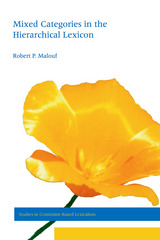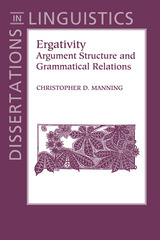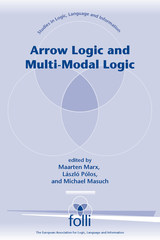308 scholarly books by CSLI and 21
have author last names that start with M
308 scholarly books by CSLI and 21
308 scholarly books by CSLI
21 have author last names that start with M have author last names that start with M
21 have author last names that start with M have author last names that start with M

Mixed Categories in the Hierarchical Lexicon
Robert P. Malouf
CSLI, 2000
Mixed category constructions like the English verbal gerund involve words that seem to be central members of more that one part of speech. This poses a problem for the standard view of syntactic categories.
This book presents a novel analysis of this and similar mixed category constructions in languages including Quechua, Tibetan, Arabic, Fijian, Dagaare, and Jacaltec. Under this analysis, Robert P. Malouf shows that verbal gerunds share the selectional properties of verbs and the distributional properties of nouns. He further shows that since different dimensions of grammatical information can vary independently, the behavior of mixed categories creates no paradox. These dimensions are in principle independent. However, certain types of mixed categories are quite common in the world's languages, while others are rare or nonexistent. The book discusses how cross-linguistic variation can be accounted for by a lexical categorial prototype. By stating these prototypes as default constraints in a hierarchy of lexical information, Malouf argues that one can bring insights from cognitive and functional approaches to linguistics into a formal analysis, thus building on the strengths of both approaches.
This book presents a novel analysis of this and similar mixed category constructions in languages including Quechua, Tibetan, Arabic, Fijian, Dagaare, and Jacaltec. Under this analysis, Robert P. Malouf shows that verbal gerunds share the selectional properties of verbs and the distributional properties of nouns. He further shows that since different dimensions of grammatical information can vary independently, the behavior of mixed categories creates no paradox. These dimensions are in principle independent. However, certain types of mixed categories are quite common in the world's languages, while others are rare or nonexistent. The book discusses how cross-linguistic variation can be accounted for by a lexical categorial prototype. By stating these prototypes as default constraints in a hierarchy of lexical information, Malouf argues that one can bring insights from cognitive and functional approaches to linguistics into a formal analysis, thus building on the strengths of both approaches.
[more]

Ergativity
Argument Structure and Grammatical Relations
Christopher D. Manning
CSLI, 1996
This volume considers and examines some of the phenomena that have led languages to be considered 'ergative'. Languages considered 'ergative' have only been sparsely studied, and many fundamental questions in their analysis seem at best incompletely answered. This volume fills that void by focussing on some of the basic issues: when ergativity should be analyzed as syntactic or morphological; whether languages can be divided into two classes of syntactically and morphologically ergative languages, and if so where the division should be drawn; and whether ergative arguments are always core roles or not.
Christopher Manning's codification of syntactic approaches to dealing with ergative languages is based on a hypothesis he terms the 'Inverse Grammatical Relations hypothesis.' This hypothesis adopts a framework that decouples prominence at the levels of grammatical relations and argument structure. The result is two notions of subject: grammatical subject and argument structure subject and a uniform analysis of syntactically ergative and Philippine languages. These language groups, the syntactically ergative and Philippine languages, allow an inverse mapping in the prominence of the two highest terms between argument structure and grammatical relations. A level of argument structure is shown to be particularly well motivated by the examination of syntactically ergative languages. A study of Inuit, Tagalog, and Dyirbal shows that constraints on imperative addressee and controllee selection, antecendent of anaphors, and the controller of certain adverbial clauses are universally sensitive to argument structure. Thus, these phenomena are always accusative or neutral, explaining why passive agents and causes can generally bind reflexives. However, constraints on relativization, topicalization, focussing or questioning, specificity or wide scope, coreferential omission in coordination, etc. are shown to be universally sensitive to grammatical relations. Examining just these phenomena, which are sensitive to grammatical relations, it becomes evident that many languages are indeed syntactically ergative, and so must be countenanced by linguistic theory.
This volume combines good scholarship with innovative ideas into an important work that will appeal to a wide range of linguists and scholars.
[more]

Arrow Logic and Multi-Modal Logic
Maarten Marx
CSLI, 1996
Conceived by Johan van Benthem and Yde Venema, arrow logic started as an attempt to give a general account of the logic of transitions. The generality of the approach provided a wide application area ranging from philosophy to computer science. The book gives a comprehensive survey of logical research within and around arrow logic. Since the natural operations on transitions include composition, inverse and identity, their logic, arrow logic can be studied from two different perspectives, and by two (complementary) methodologies: modal logic and the algebra of relations. Some of the results in this volume can be interpreted as price tags. They show what the prices of desirable properties, such as decidability, (finite) axiomatisability, Craig interpolation property, Beth definability etc. are in terms of semantic properties of the logic. The research program of arrow logic has considerably broadened in the last couple of years and recently also covers the enterprise to explore the border between decidable and undecidable versions of other applied logics. The content of this volume reflects this broadening. The editors included a number of papers which are in the spirit of this generalised research program.

